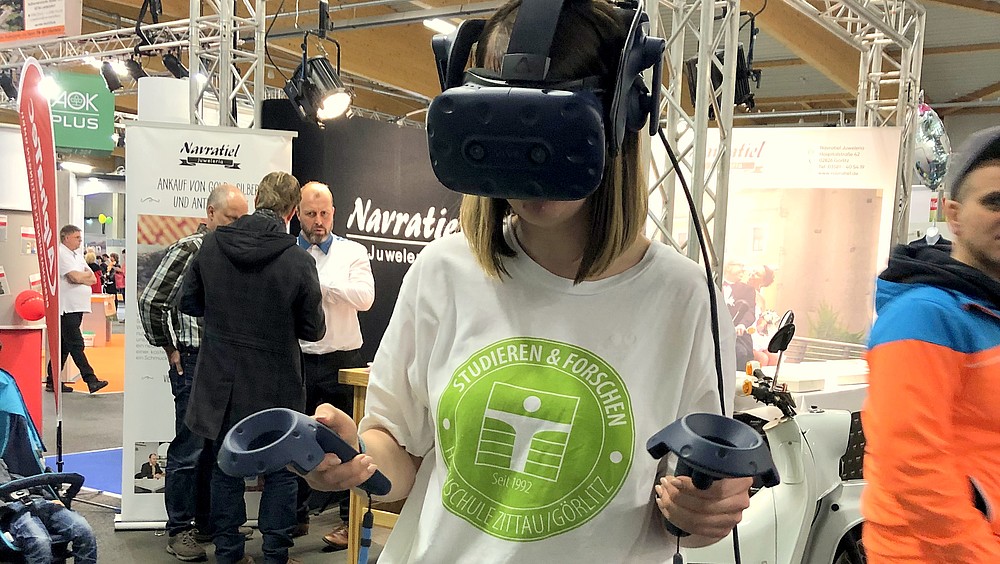The HSZG caused a long queue at KONVENT'A at the weekend with virtual reality glasses.

"It's addictive!" the 10-year-old girl is sure of it. She is wearing the VR goggles most of all this Sunday. Together with her mother and numerous other visitors, she is a guest at this year's KONVENT'A, the 18th Oberlausitzer Gewerbe - und Leistungsschau, which took place in the Löbauer exhibition hall from April 27 to 28. The trade fair is regarded as an innovative exhibition and contact platform for trade, education, services, leisure and tourism. The presence of the Zittau/Görlitz University of Applied Sciences was also innovative on both days.
Even though the exhibition space was considerably smaller than in previous years, the nine square meters available were filled with a lot of life and a great offer for young and old. The only highs and lows were the main exhibit, a pair of virtual reality glasses provided by the Faculty of Mechanical Engineering. The girl was almost offended when other visitors wanted to see and experience the latest technology with their own eyes. She waited patiently all day until she was able to beam herself - the goggles almost bigger than her head - into real mountain worlds, laboratories or component constructions.
Meanwhile, in the flower hall, a WerkSchau exhibition together with regional exhibitors showed how much potential there is in Saxony and the region and what great, innovative and sustainable products can be found here. In addition to exhibitors from the cultural and creative industries, bands, DJs, a quiz, a small Kunstbauer cinema, a rally, artists, graffiti artists, poetry slams and fashion shows provided a perfect supporting program.
While the sandbox was incredibly interesting last year and attracted visitors of all ages to the HSZG stand, the VR glasses took first place at this year's Convention. Nevertheless, whether primary school pupils, prospective HSZG students, their parents or grandparents, all generations were fascinated by the opportunity to create their own landscapes and entire mountain ranges. "You can even make it rain," explains Marco Hartmann. He is a study scout at the Faculty of Electrical Engineering and Computer Science' and, together with Egmont Schreiter, has adapted an open source construction plan for Zittau to create the wondrous and motion-simulated sand coloring. Outstretched palms above the sandpit are interpreted by the camera as clouds. Raindrops are generated and color the sand surface below the hand movements blue.
"This is magic sand," Justus says happily, just as high as the sandbox. He digs and digs with both hands full of joy. The highlight? Red, orange, beige, green and blue rings and abstract areas run through the sand. Where he piles up sandcastles, the red areas on the peaks indicate the heights of this self-created mountain range. The deep sand trenches, which represent the valleys with their small lakes or rivers, are colored blue. With a wave of the hand, an orange-colored hill can emerge from such a valley.
An infrared camera set up above the sandbox makes this possible. "It photographs the snapshot, from which a value is calculated in the connected computer and converted into an image that is projected onto the sand," explains Marco Hartmann. "First you have to define the zero line. The plus and minus areas for this then eject the different color schemes. This results in the different colored height and depth patterns. This is a great way to visualize different heights."
In addition to the sandbox and the ultimate VR goggles, visitors to the fair were able to find out about study opportunities at the HSZG, try their hand at highly complicated wooden cubes with lots of components or enjoy the small souvenirs in the form of pens or badges.
A big thank you goes to all those who supported the Public Relations Office this weekend, especially Marco Hartmann from the Faculty of Electrical Engineering and Computer Science for supervising the augmented reality sandbox and Matthias Hermann and his team from the Faculty of Mechanical Engineering for the VR glasses, as well as our in-house technicians Henry Beyer and Steffen Günzel.